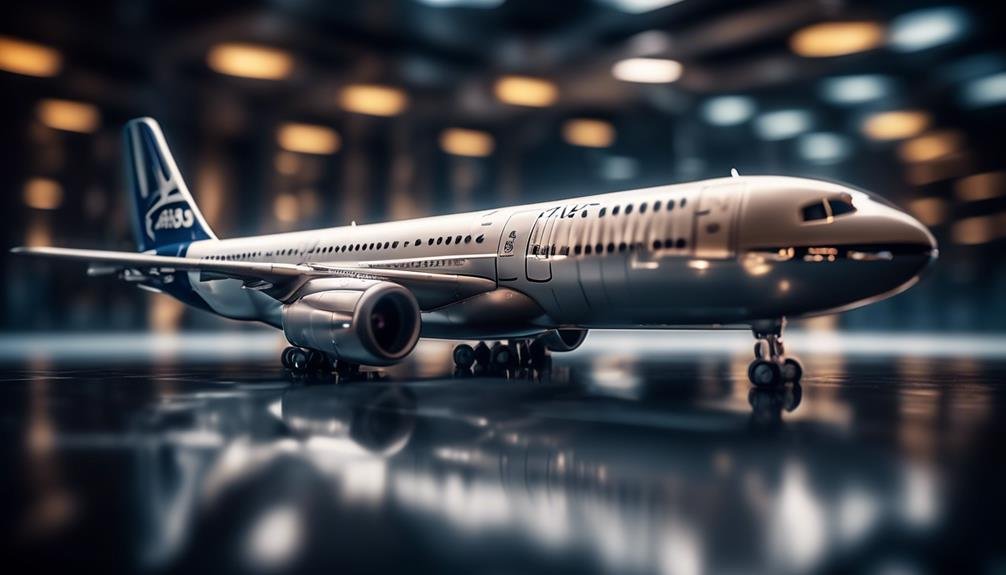Airbus A3XX: A Case Study in Innovation
The Airbus A3XX represents a pivotal moment in the aviation industry, showcasing a blend of technological innovation, strategic foresight, and engineering prowess.
As we explore the intricate details of this case study, we unravel the complexities involved in bringing to life a groundbreaking aircraft that challenged conventional norms and redefined the possibilities of air travel.
From the initial conceptualization to the meticulous execution and the subsequent impact on the market, the A3XX serves as a compelling example of how innovation can shape an entire industry.
Join us as we dissect the various elements that contributed to the development and success of this ambitious project.
The Birth of A3XX
The inception of the Airbus A3XX marked a significant milestone in the history of aviation, representing a bold leap forward in the evolution of commercial aircraft. The birth of A3XX was a result of innovative engineering that aimed to disrupt the industry.
The Airbus A3XX, later known as the Airbus A380, was conceived to address the growing demand for air travel and the limitations of existing aircraft. The innovative engineering behind the A3XX allowed for the development of the world's largest passenger airliner, capable of carrying more passengers than ever before. This disruptive approach challenged the traditional market dominated by Boeing's 747, introducing a new era of air travel.
The A3XX's innovative engineering not only pushed the boundaries of aircraft design but also revolutionized the aviation industry, setting new standards for size, efficiency, and passenger comfort. The birth of A3XX not only represented a new chapter in aviation history but also exemplified how innovative engineering can lead to industry disruption, driving forward the progress of commercial aircraft.
Revolutionary Design Concepts
Representing a paradigm shift in aircraft engineering, the revolutionary design concepts of the Airbus A3XX challenged conventional norms and set a new trajectory for the future of commercial aviation.
The A3XX's revolutionary engineering is exemplified by its innovative aerodynamics, which were meticulously crafted to enhance fuel efficiency, reduce noise levels, and improve overall performance. The aircraft's large wingspan and advanced wing design allowed for increased lift capacity, enabling the A3XX to carry more passengers and cargo over longer distances. Additionally, the incorporation of composite materials in its construction contributed to a lighter yet stronger airframe, further optimizing fuel consumption and reducing operational costs.
Furthermore, the A3XX's unique 'double-deck' design not only maximized passenger capacity but also offered a spacious and comfortable travel experience. This groundbreaking approach to aircraft architecture redefined the possibilities for interior cabin layouts, catering to diverse customer needs and preferences.
Moreover, the A3XX's innovative approach to environmental sustainability, including reduced emissions and noise pollution, set a new standard for the industry.
Ultimately, the Airbus A3XX's revolutionary design concepts not only pushed the boundaries of traditional aircraft engineering but also paved the way for a new era of advanced, efficient, and passenger-centric commercial aviation.
Advanced Technological Integration
The Airbus A3XX stands at the forefront of technological integration in the aviation industry.
The aircraft boasts cutting-edge avionics systems that enhance navigation, communication, and flight management.
Furthermore, the seamless software integration ensures a cohesive and efficient operation, setting new standards for aircraft technology.
Cutting-Edge Avionics Systems
Featuring state-of-the-art avionics systems, the Airbus A3XX represents a pinnacle of advanced technological integration in the aviation industry. The avionics integration on the A3XX has significantly impacted the industry, setting new standards for safety, efficiency, and pilot experience. Here are the key aspects:
- Integrated Flight Management System (FMS): The A3XX boasts a cutting-edge FMS that seamlessly integrates navigation, autopilot, and aircraft performance data, enhancing precision and reducing pilot workload.
- Advanced Cockpit Displays: The aircraft is equipped with high-resolution, multifunctional displays that provide pilots with real-time data on navigation, weather, and aircraft systems, improving situational awareness and decision-making.
- Fly-By-Wire Technology: Airbus has implemented sophisticated fly-by-wire systems, enabling precise control and automation, thereby enhancing safety and operational efficiency.
The A3XX's avionics systems have set a new benchmark for technological innovation in the aviation industry.
Seamless Software Integration
As the aviation industry continues to evolve, the seamless integration of advanced software systems stands as a cornerstone of technological innovation, ensuring the Airbus A3XX remains at the forefront of modern aircraft design.
Software development for the Airbus A3XX involves addressing complex integration challenges to ensure that various systems work together harmoniously. This requires meticulous coordination between different software modules, such as flight control, navigation, communication, and maintenance systems.
Integration challenges also encompass compatibility issues between newly developed software and existing systems, as well as the need to meet stringent safety and reliability standards. To overcome these challenges, Airbus employs rigorous testing and validation procedures to guarantee that the software functions seamlessly within the aircraft's overall operational framework.
This approach not only enhances the A3XX's performance but also sets new standards for advanced technological integration in the aviation industry.
Overcoming Development Challenges
Despite encountering numerous development challenges, the Airbus A3XX project persevered through innovative problem-solving and strategic decision-making. The development of the A3XX faced significant hurdles, but the project team's collaborative problem-solving approach and engineering breakthroughs were instrumental in overcoming these obstacles.
- Collaborative Problem-Solving:
The A3XX development team fostered a culture of collaboration, bringing together experts from various fields to address complex technical issues. By encouraging open communication and the exchange of ideas, the team was able to tackle challenges effectively.
- Engineering Breakthroughs:
The project encountered engineering challenges related to the aircraft's size and weight, as well as the integration of advanced technologies. The team's innovative engineering solutions, such as advanced lightweight materials and structural design optimizations, were pivotal in surmounting these obstacles.
- Strategic Decision-Making:
The project leadership made critical decisions to reallocate resources, adjust timelines, and revise design approaches based on the evolving challenges. Their strategic foresight and adaptability ensured that the project stayed on course despite the unforeseen hurdles.
The Airbus A3XX project's ability to navigate and conquer its development challenges exemplifies the importance of innovative problem-solving and strategic decision-making in complex technological endeavors.
Marketing and Industry Impact
The successful navigation of development challenges in the Airbus A3XX project laid a strong foundation for its impactful marketing strategies and significant influence on the aviation industry.
Airbus employed a multifaceted marketing approach to promote the A3XX, leveraging its advanced features and unparalleled capacity to attract global airlines. The company strategically highlighted the aircraft's fuel efficiency, spacious cabin design, and potential for increased profitability, enticing airlines with the prospect of enhanced operational performance and passenger satisfaction. This targeted marketing effort contributed to the successful positioning of the A3XX as a game-changer in the aviation industry, prompting a shift in the market dynamics.
Furthermore, the economic impact of the A3XX cannot be overstated. The aircraft's introduction led to a significant ripple effect across the aviation industry, creating job opportunities, fostering technological advancements, and boosting local economies in regions involved in its production and operation.
Additionally, the A3XX's sheer size and passenger capacity revolutionized air travel, stimulating demand for enhanced infrastructure and services at airports worldwide. As a result, the Airbus A3XX not only redefined long-haul travel but also left an enduring imprint on the global aviation landscape.
Future Prospects and Innovations
As we look ahead, the future prospects and innovations of the Airbus A3XX are promising.
The technological advancements in aircraft design and manufacturing are set to revolutionize the industry, presenting opportunities for enhanced efficiency and performance.
Moreover, the market potential and competitive landscape are key areas to monitor as the A3XX aims to carve out its position in the global market.
Technological Advancements
Advancements in aerospace technology are poised to revolutionize the capabilities and efficiencies of the Airbus A3XX, paving the way for unprecedented innovation in the aviation industry.
- Technological Evolution:
Integration of advanced materials, such as carbon composites, will significantly reduce the aircraft's weight, enhancing fuel efficiency and performance.
- Engineering Breakthroughs:
Adoption of state-of-the-art propulsion systems and aerodynamic enhancements will elevate the A3XX's operational efficiency and environmental sustainability.
- Innovation Impact:
Implementation of cutting-edge avionics and autonomous systems will streamline operations, ensuring enhanced safety and passenger experience while contributing to industry-wide operational transformation.
These technological advancements are not only set to redefine the Airbus A3XX but also have the potential to reshape the entire aviation landscape, propelling the industry into a new era of efficiency and sustainability.
Market Potential
With a forecasted surge in global air travel demand, the Airbus A3XX stands at the forefront of future prospects and innovations, poised to revolutionize the aviation industry.
Market analysis indicates that the A3XX's entry into service will have a significant economic impact, stimulating consumer demand and driving industry growth.
As the market for air travel continues to expand, especially in emerging economies, the A3XX's introduction addresses the growing need for larger capacity aircraft to meet the escalating demand for long-haul travel.
The economic impact of the A3XX is anticipated to be substantial, not only for Airbus but also for the broader aviation ecosystem. With its advanced technology and unparalleled capacity, the A3XX is well-positioned to capture a significant share of the market, further solidifying Airbus's competitive advantage in the industry.
Competitive Landscape
In evaluating the competitive landscape within the aviation industry, it is imperative to scrutinize the future prospects and innovations that are set to redefine the dynamics of air travel.
Advancements in Sustainable Aviation:
The industry is witnessing a shift towards sustainable aviation, with a growing emphasis on eco-friendly aircraft and alternative fuels. This presents an opportunity for companies to gain a competitive advantage by positioning themselves as environmentally conscious and technologically innovative.
Digital Transformation and Connectivity:
The integration of advanced digital technologies, such as in-flight connectivity and data analytics, is reshaping the passenger experience and operational efficiency. Companies that can leverage these innovations effectively will enhance their market positioning and customer satisfaction.
Urban Air Mobility:
The emergence of urban air mobility solutions, including electric vertical takeoff and landing (eVTOL) aircraft, is poised to revolutionize short-distance travel, offering new avenues for competitive differentiation and market expansion.
Conclusion
In conclusion, the Airbus A3XX stands as a pinnacle of innovation in the aviation industry. Its birth marked a revolution in design and technological integration, overcoming significant development challenges.
The aircraft's impact on marketing and the industry as a whole has been substantial. Looking ahead, the A3XX continues to inspire future prospects and innovations, setting a new standard for the future of air travel.
Its impact can be likened to a meteor shower of groundbreaking advancements in aviation.







